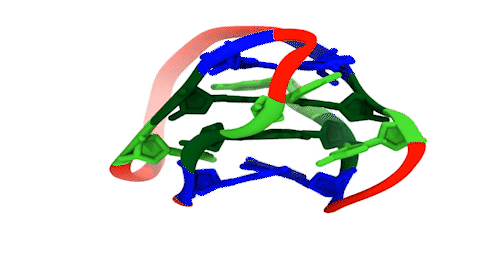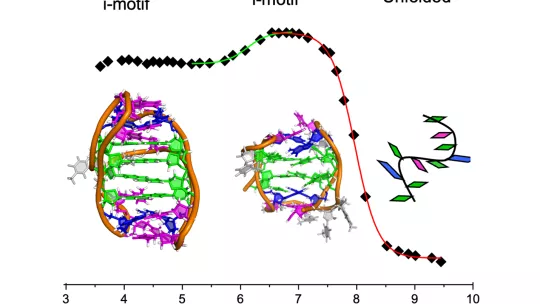Images
- The study characterises i-DNA sequences that can change shape depending on the pH of the environment.
- The description of these biomolecules is expected to further the development of new nanometric devices.
- The work has been published in the Journal of the American Chemical Society (JACS).
In 1953, the main structure of DNA was discovered as a double helix. This biomolecule is highly flexible and therefore presents a wide variety of structures. DNA has four nitrogenous bases, namely cytosine (C), guanine (G), adenine (A), and thymine (T), which are located in the form of base pairs at the centre of the molecule. In the double helix, the base pairs are formed by G with C and A with T. However, in some cases, such as the i-motif, also known as i-DNA, the base pair is formed by a C with another C. This structure can occur transiently at certain points of the cell cycle, but its function is unknown.
Using Nuclear Magnetic Resonance (NMR), researchers from IRB Barcelona led by Dr. Modesto Orozco, in collaboration with Dr. Nuria Escaja, from the Department of Inorganic and Organic Chemistry of the University of Barcelona, and Dr. Carlos González, from the Rocasolano Physical Chemistry Institute (CSIC), have characterised two distinct conformations of a pH-dependent DNA molecule. In addition, this transition has been described with molecular dynamics studies, which have demonstrated that the unfolding of the i-motif is not necessary for changes in its conformation. This is the first study to report the conformational change of i-DNA and it reveals the plasticity of these structures.
Published in The Journal of the American Chemical Society (JACS), the study is the continuation of previously published work, which described the behaviour of some peculiar i-motifs that are stable in neutral environments. In this new study, the scientists analysed the behaviour of certain sequences in environments with differing degrees of acidity (different pH). These structures can form transiently at certain points of the cell cycle, but their function is not yet known and is the object of study.

Technological progress in biomedicine
Nanotechnology involves the precise manipulation of atoms and molecules to manufacture micro-scale products. This relatively new technology has a very wide range of applications, including diverse fields of science, spanning surface science, organic chemistry, molecular biology, semiconductor physics, micromanufacturing, and biomedicine, among others.
This work is an important advance in the understanding of the DNA but, above all, of the i-DNA variant. This biomolecule and the possible changes in its structure can participate in the modulation of genes and, at the same time, it is also involved in the development of nanotechnology. “The existence of biomolecules, such as the one described in this study, which are capable of modifying their structure, enable de development of technological devices on a nanometric scale,” says Dr. Israel Serrano, a postdoctoral researcher at IRB Barcelona and first author of the study.
This research was funded by the Ministry of Science and Innovation, the Center of Excellence for HPC, H2020 European Commission, the BioExcel-2 Center of Excellence for Computational Biomolecular Research, and the Instituto de Salud Carlos III−National Institute of Bioinformatics. In this study, instrumentation at the "Manuel Rico" laboratory, a node of the biomolecular NMR laboratory network, a Singular Scientific and Technical Infrastructure (ICTS) has been key.
Related article:
pH-Dependent Capping Interactions Induce Large-Scale Structural Transitions in i‐Motifs
Israel Serrano-Chacón, Bartomeu Mir, Lorenzo Cupellini, Francesco Colizzi, Modesto Orozco, Núria Escaja, and Carlos González.
The Journal of the American Chemical Society (2023). DOI: 10.1021/jacs.2c13043
About IRB Barcelona
The Institute for Research in Biomedicine (IRB Barcelona) pursues a society free of disease. To this end, it conducts multidisciplinary research of excellence to cure cancer and other diseases linked to ageing. It establishes technology transfer agreements with the pharmaceutical industry and major hospitals to bring research results closer to society, and organises a range of science outreach activities to engage the public in an open dialogue. IRB Barcelona is an international centre that hosts 400 researchers and more than 30 nationalities. Recognised as a Severo Ochoa Centre of Excellence since 2011, IRB Barcelona is a CERCA centre and member of the Barcelona Institute of Science and Technology (BIST).









